List of Contents
Environmental Remediation Market Size and Forecast 2025 to 2034
The global environmental remediation market size was estimated at USD 124.04 billion in 2024 and is predicted to increase from USD 142.17 billion in 2025 to approximately USD 485.47 billion by 2034, expanding at a CAGR of 14.62% from 2025 to 2034. The growth of the market is driven by the increasing concerns about pollution and stringent government regulations regarding environmental protection.
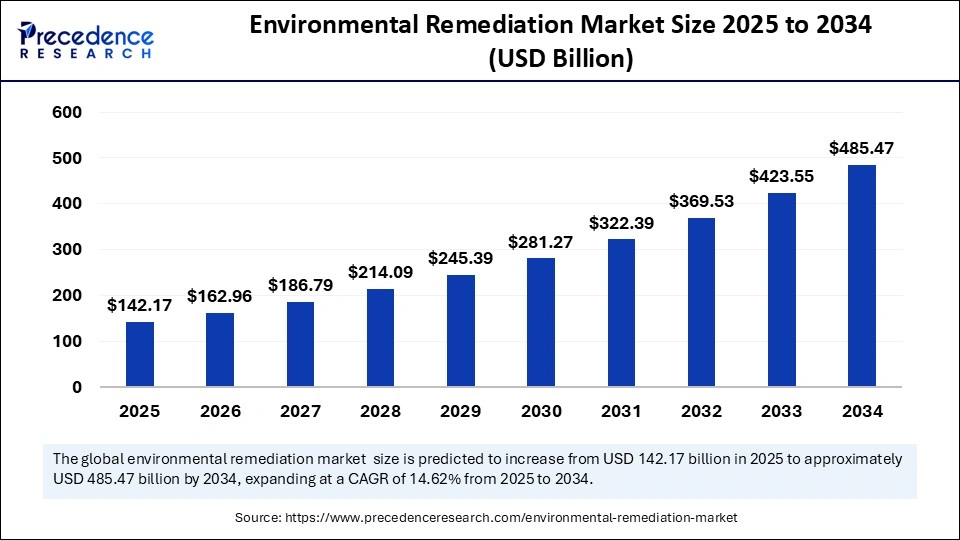
Environmental Remediation Market Key Takeaways
- Asia Pacific dominated the environmental remediation market with the largest share of 39% in 2024.
- North America is expected to expand at the highest CAGR during the forecast period.
- By site type, the public segment contributed the biggest market share of 69% in 2024.
- By site type, the private segment is expected to grow at a CAGR of 7.9% during the projected timeframe.
- By medium, the soil segment held the largest market share of 30% in 2024.
- By medium, the water segment is projected to expand at a CAGR of 8% during the forecast period.
- By end-user, the oil and gas segment accounted for the highest market share of 30% in 2024.
- By end-user, the waste management segment is expected to grow at a CAGR of 8-01% in the coming years.
Howcan AI improve the efficiency and impact of environmental remediation?
Advancements in intelligent technologies are transforming the environmental remediation landscape by streamlining data processing, enhancing predictive accuracy, and enabling real-time decision-making. Artificial Intelligence AI technologies analyze vast amounts of data from water, soil, and air samples to identify contaminants and optimize remediation strategies. AI-driven tools improve adherence to environmental laws and ESG pledges while lowering operating expenses. Utilizing data-driven remediation techniques has become a competitive advantage as industries face increasing pressure to implement sustainable practices.
- Recently, a US-based company, Clarity, unveiled an AI-driven remediation system. This system is specifically designed to speed up the removal of PFAS from groundwater, reducing treatment time by almost 40%.
Asia Pacific Environmental Remediation Market Size and Growth 2025 to 2034
The Asia Pacific environmental remediation market size was exhibited at USD 48.38 billion in 2024 and is projected to be worth around USD 191.76 billion by 2034, growing at a CAGR of 14.76% from 2025 to 2034.
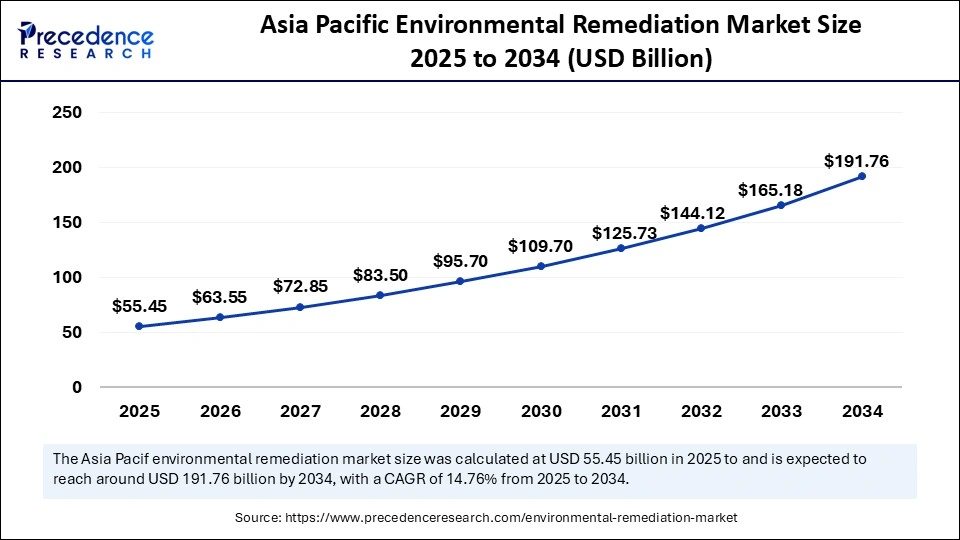
Asia Pacific held the largest share of the environmental remediation market in 2024. The region's market dominance is mainly attributed to rapid industrialization, leading to rising contaminated sites. There is heightened awareness about environmental sustainability. The region is likely to sustain its position in the market in the coming years due to the growing concerns about problems such as air and water pollution and the disposal of hazardous waste. The demand for environmental remediation technologies keeps rising in the region as a result of increased efforts by both public and private entities to address environmental issues.
North America is projected to experience the fastest growth during the forecast period. The regional market growth is mainly attributed to stringent environmental regulations and a strong emphasis on environmental sustainability. Governments around the region have imposed stringent regulations regarding waste management, encouraging industries to invest in environmental remediation technologies. The region boasts a large industrial base, leading to a significant number of contaminated sites. The increasing concerns about air and water pollution further bolster the market growth in the region. Moreover, there is high adoption of eco-friendly solutions and sustainable practices, speeding up remediation efforts.
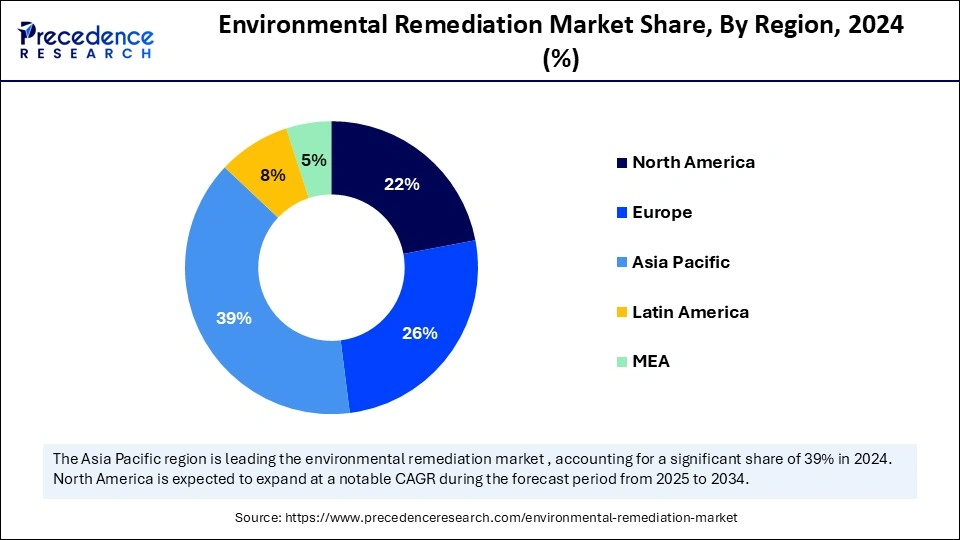
Europe is observed to grow at a considerable growth rate in the upcoming period. The growth of the environmental remediation market in Europe can be driven by stringent environmental regulations. The European Union has imposed strict regulations regarding environmental protection, encouraging businesses to invest in remediation solutions to comply. There is a strong focus on lowering pollution, cleaning up contaminated areas, and enhancing ecosystem health. The rising demand for eco-friendly remediation techniques further fuels the growth of the market. To help meet the region's strict environmental standards, European organizations are investing heavily in cutting-edge remediation technologies, propelling regional market growth.
Market Overview
The environmental remediation market is experiencing significant growth, driven by escalating industrial pollution, stringent environmental regulations, and heightened awareness of ecological sustainability. Innovative cleanup techniques like thermal treatment and bioremediation are being used by industries more and more to efficiently manage contamination. The market is growing as a result of the redevelopment of contaminated areas for new infrastructure projects. Government programs are essential to this growth trajectory.
The Indian Government's Green Credit Program, launched in October 2023, incentivizes voluntary environmental actions across various sectors, promoting activities like plantation on degraded wastelands. Additionally, the Namami Gange Program, with a budget outlay of Rs 22,500 crore for 2023-26, continues its mission to rejuvenate the Ganga River through pollution abatement and conservation efforts. These initiatives underscore commitment to environmental restoration and compliance, thereby boosting the demand for remediation solutions.
Environmental Remediation Market Growth Factors
- Rising Industrial Pollution: Increasing contamination from manufacturing, mining, and chemical industries boosts the demand for remediation solutions.
- Stringent Environmental Regulations: Governments worldwide are enforcing stricter cleanup standards and pollution control laws, propelling the market's growth.
- Technological Advancements: Innovations in bioremediation, nanotech, and thermal treatment make cleanup more efficient and cost-effective.
- Climate Change Impact: Extreme weather events are exposing buried contaminants, increasing the need for site restoration.
Increased Brownfield Redevelopment: Revitalization of previously contaminated sites is creating new market opportunities.
Market Scope
| Report Coverage | Details |
| Market Size by 2034 | USD 485.47 Billion |
| Market Size in 2025 | USD 142.17 Billion |
| Market Size in 2024 | USD 124.04 Billion |
| Market Growth Rate from 2025 to 2034 | CAGR 14.62% |
| Dominated Region | Asia Pacific |
| Fastest Growing Market | North America |
| Base Year | 2024 |
| Forecast Period | 2025 to 2034 |
| Segments Covered | Site Type, Medium, End User, and Region |
| Regions Covered | North America, Europe, Asia-Pacific, Latin America and Middle East & Africa |
Market Dynamics
Drivers
Growing Urbanization
Growing urbanization is a key factor driving the growth of the environmental remediation market. With rapid urbanization, the demand for redeveloping previously contaminated or industrial land into commercial or residential areas is increasing. Environmental remediation technologies are essential for quickly evaluating land for reuse, determining contamination levels, suggesting remediation techniques, and streamlining land development plans. These tools lessen the environmental impact of redevelopment projects and speed up regulatory approvals. Remediation solutions help maximize the potential of underutilized land while guaranteeing it satisfies environmental standards for safe reuse. As governments and the private sectors seek to revitalize urban areas, the demand for remediation solutions is expected to rise.
Disaster Response and Climate Resilience
Natural and manmade disasters are increasingly affecting communities and industries, leading to more frequent and several environmental contamination events. AI-based remediation solutions can enable quicker, more effective responses by evaluating satellite data, weather conditions, and contamination spread to identify the best cleanup tactics. This prevents long-term environmental harm and safeguards ecosystems. Advanced environmental remediation technologies play a key role in future climate resilience planning since they can detect areas that are at risk and suggest preventative remediation action. These technologies, especially AI-driven, are increasingly being used in disaster management to create long-term plans for climate resilience.
Restraints
Regulatory and Legal Barriers
The environmental sector is heavily regulated, and AI adoption in remediation efforts faces scrutiny from regulatory bodies, which affects the growth of the environmental remediation market. Standardized frameworks for the application of AI in environmental cleanups are lacking. This raises questions regarding potential noncompliance with environmental regulations as well as the liability of AI-driven decisions. AI-based remediation techniques may take longer to be approved by regulatory bodies because they raise concerns about accountability or transparency in the decision-making process.
Data Security and Privacy Issues
Concerns regarding data security and privacy limit the adoption of AI-driven environmental remediation technologies, which hinders the growth of the environmental remediation market. AI-based systems used in environmental remediation raise the risk of data breaches, cyberattacks, and privacy violations because they gather and analyze enormous volumes of data. Businesses need to make sure that their data management systems are secure, particularly when sensitive environmental data is involved, like pollution levels or remediation plans for locations. Protecting private information, sensitive site data, and intellectual property associated with environmental projects is crucial.
Opportunities
The Movement Toward Environmental Justice
AI presents an opportunity to support the environmental justice movement by providing real-time monitoring of pollution and contamination levels. AI can analyze environmental data to find patterns and trends that might be overlooked, like cumulative exposure to harmful substances over time. This guarantees that at-risk communities that are frequently impacted by environmental neglect receive the attention they require and helps identify areas that require remediation immediately. To protect the most vulnerable groups, policymakers must use AI to prioritize interventions. Equitable environmental results may result from this proactive data-driven strategy.
Bioremediation and Phytoremediation Advances
Advancements in bioremediation and phytoremediation create immense opportunities in the environmental remediation market. Phytoremediation, which uses plants to remove contaminants from soil and water, and bioremediation, which uses microorganisms to break down pollutants, present numerous opportunities for environmentally friendly and viable cleanup techniques. More research is being done on improving the effectiveness of these biological treatments by using improved microbial strains or genetic alterations. For instance, phytoremediation could be expanded for widespread application in industrial or agricultural settings, providing affordable, environmentally friendly options for long-term site management and pollution control.
Site Type Insights
The public segment dominated the environmental remediation market with the largest share in 2024. This is mainly due to increased public sector participation in environmental remediation, driven by calls to address legacy contamination in urban and rural areas. To enhance land use and public health, national and local governments prioritize the cleanup of brownfield sites, former military zones, and municipal waste areas. International climate goals and cross-sector collaborations are speeding up the long-term interventions that are frequently needed for public sector projects. The sector is gaining momentum due to the increasing incorporation of environmental remediation into infrastructure development and urban renewal initiatives. Furthermore, governments are being compelled to implement contemporary remediation technologies to meet international environmental standards, supporting the growth of the segment.
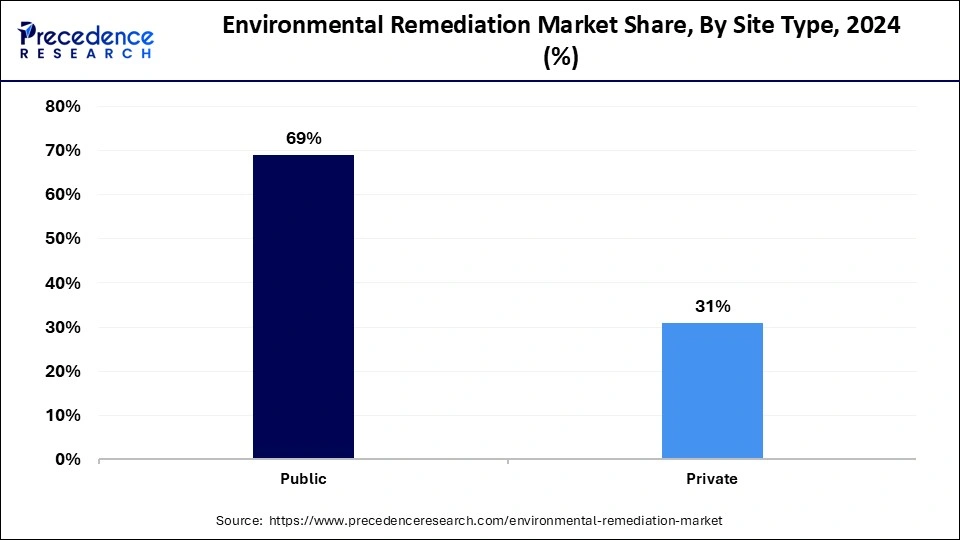
The private segment is expected to witness the fastest growth during the projected timeframe. The growth of the segment can be attributed to the rising sustainability pledges among business and industrial stakeholders. To stay in compliance with regulations, manufacturing plants, oil refineries, and construction companies are making significant investments in cleanup efforts. As the importance of ESG (Environmental, Social, and Governance) practices increases, businesses start remediation projects early as a strategic business advantage rather than just a need. The private sector is quickly embracing data-driven remediation and sustainable cleanup techniques to foster decision-making, enabling quicker implementation of remediation solutions.
Medium Insights
The soil segment led the environmental remediation market in 2024, driven by concerns about agricultural productivity, health hazards of contaminated soil, and growing awareness of land degradation. Numerous locations have hazardous residues, including mining sites. Inappropriate waste disposal necessitates extensive cleanup efforts. Reviving such lands for safer use is a priority of both the public and private sectors. Technologies like chemical oxidation, thermal desorption, and phytoremediation are suitable for soil remediation.
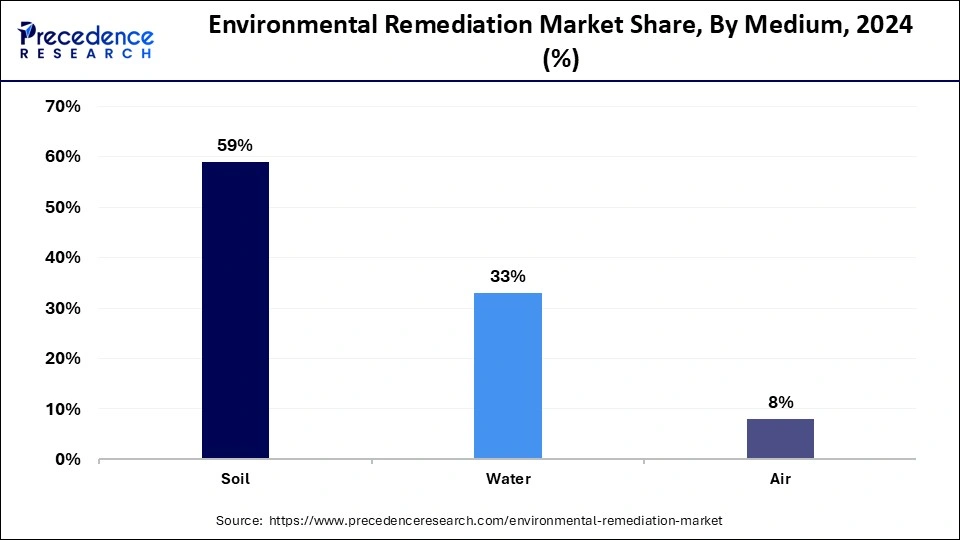
The water segment is projected to expand at the highest CAGR during the forecast period. The growth of the segment is attributed to the growing worries about industrial wastewater discharge, drinking source contamination, and water quality. There is an urgent need for remediation because heavy metals, chemicals, and untreated effluents pollute both surface and groundwater bodies. Strict water protection regulations and rising clean water demand for agricultural and residential uses are likely to boost the growth of the segment. Public and private organizations are making significant investments to purify water bodies, contributing to segmental growth.
End-User Insights
The oil & gas segment held the largest share of the environmental remediation market in 2024, driven by growing environmental responsibilities and heightened awareness of pollution linked to hydrocarbons. Since oil and gas manufacturing companies emit huge amounts of greenhouse gases, they require effective remediation solutions to minimize environmental damage. Large-scale cleanup is necessary due to the substantial contamination that is frequently left behind by exploration, drilling, and refining operations, especially in soil and groundwater. Oil and gas manufacturing companies are now incorporating remediation into their operations to reduce their environmental impact. To satisfy sustainability and regulatory requirements, the industry is progressively implementing in situ and ex-situ chemical treatments and microbial solutions. Stringent regulations to reduce emissions further boosted the demand for environmental remediation technologies in the oil & gas industry.
The waste management segment is expected to grow at the fastest rate in the coming years because the amount of hazardous municipal and industrial waste produced worldwide is growing. There is a heightened adoption of environmental remediation technologies among recycling facilities and waste treatment facilities. The industry is constantly investing in cutting-edge remediation methods and monitoring systems due to stringent regulations regarding waste management. There is a strong focus on cleaning up and reusing contaminated sites, boosting the demand for remediation solutions.
Environmental Remediation Market Companies
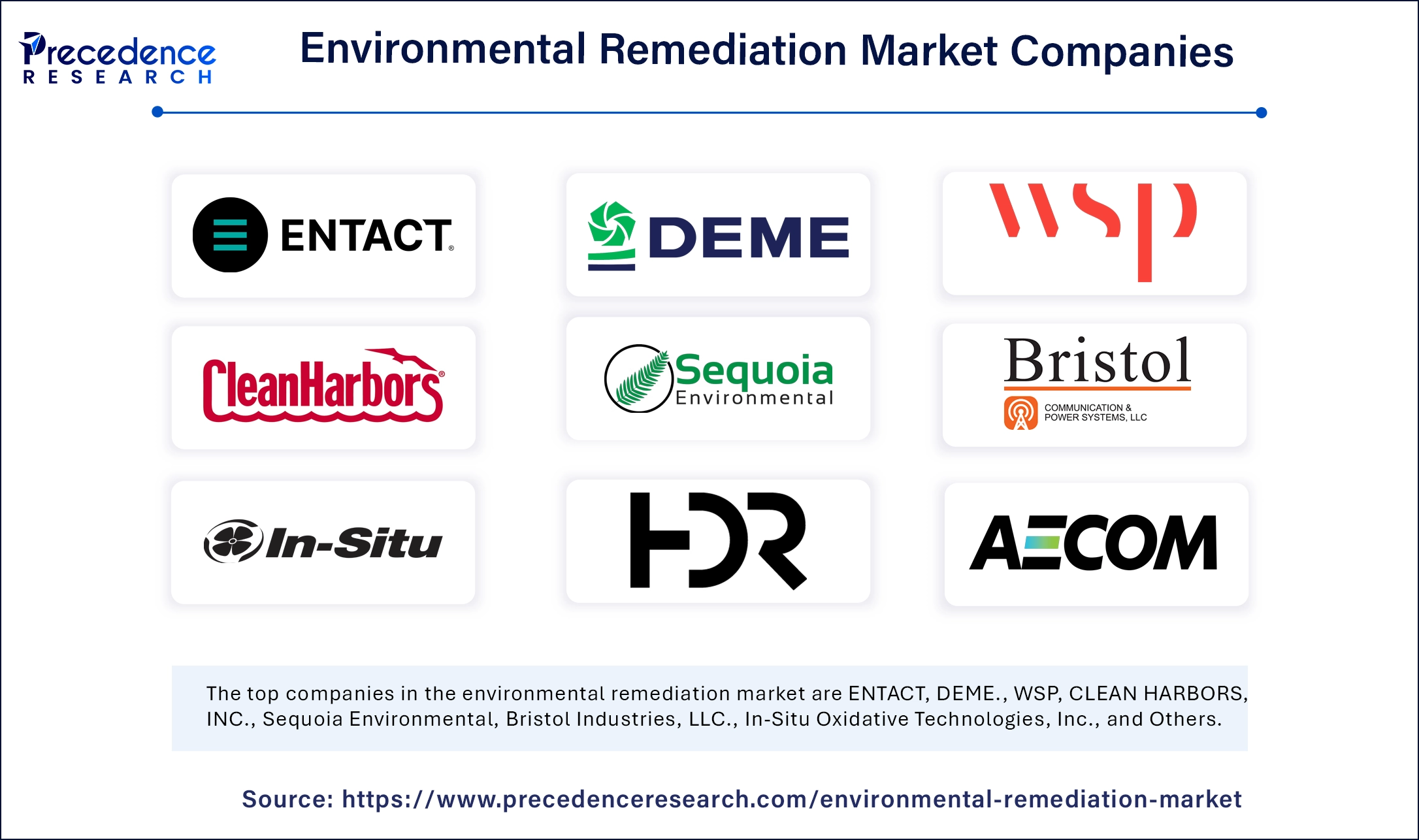
- ENTACT
- DEME.
- WSP
- CLEAN HARBORS, INC.
- Sequoia Environmental
- Bristol Industries, LLC.
- In-Situ Oxidative Technologies, Inc.
- HDR, Inc.
- AECOM.
- Tetra Tech Inc.
- BRISEA
- Jacobs
LatestAnnouncement by Industry Leader
- In April 2024, AECOM was selected by NASA to provide environmental restoration and compliance services at facilities across the U.S. The five-year contract includes environmental sampling, investigations of potential environmental contaminants, and remediation activities with a focus on PFAS-related initiatives. Michael S. Burke, Chairman and CEO of AECOM, said, "We are honed to support NASA's environmental restoration efforts and contribute to their sustainability goals.”
Recent Development
- In January 2025, Terra Systems, Inc. introduced a new bioremediation solution to treat oil spills using genetically enhanced microorganisms that speed up the breakdown of hydrocarbons. This product is expected to revolutionize how marine and coastal ecosystems handle oil contaminations, improving recovery rates and reducing cleanup times.
Segments Covered in the Report
By Site Type
- Public
- Private
By Medium
- Soil
- Water
- Air
By End-user
- Mining & Forestry
- Oil & Gas
- Agriculture
- Automotive
- Waste Management
- Manufacturing
- Construction
- Other
By Region
- North America
- Europe
- Asia Pacific
- Latin America
- Middle East & Africa
For inquiries regarding discounts, bulk purchases, or customization requests, please contact us at sales@precedenceresearch.com
Frequently Asked Questions
Ask For Sample
No cookie-cutter, only authentic analysis – take the 1st step to become a Precedence Research client